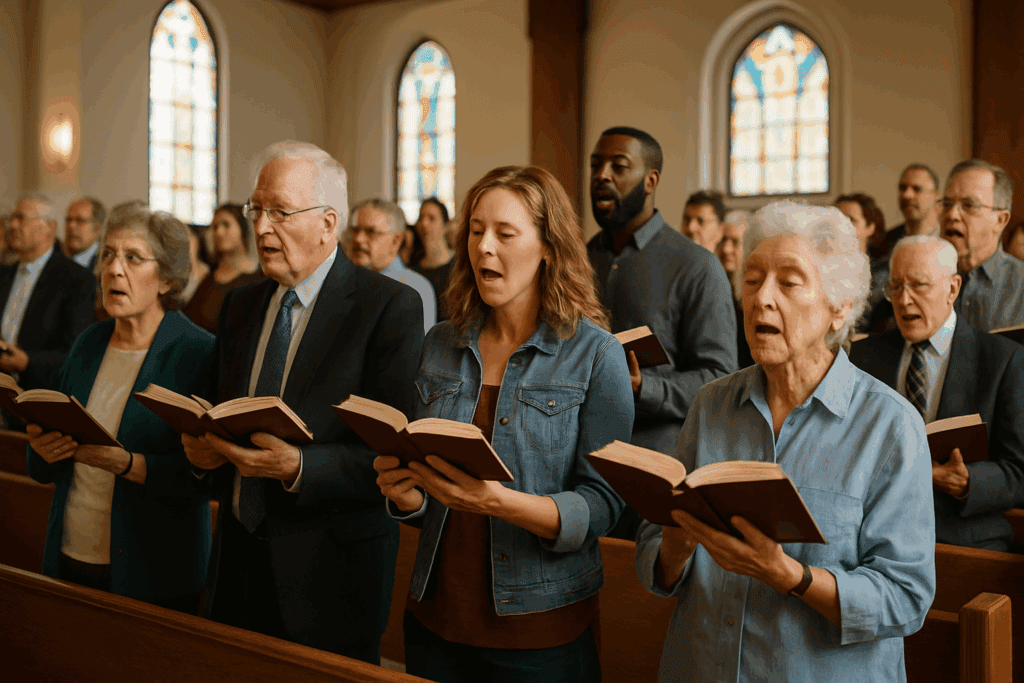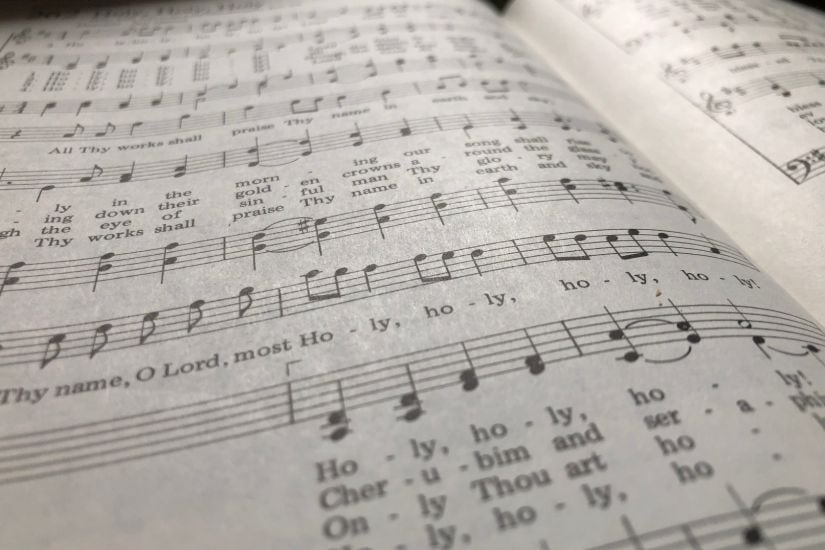Some songs don’t just last—they lead. The classic hymns of the faith have shaped generations of worshipers, offering deep truth, enduring melodies, and heartfelt devotion. While worship styles may shift over time, these hymns remain—anchoring the church in Scripture, reverence, and praise.
Often sung on Sunday mornings with organ, piano, or choir, these hymns speak of God’s holiness, grace, salvation, and sovereign love. They do more than stir nostalgia; they still minister today. With lyrics rich in theology and melody, they guide the church in truth and humility before the Lord.
In this post, we revisit 10 of the most loved classic hymns of the faith—songs that have stood the test of time and continue to lead God’s people in worship. Whether you grew up singing them or are just discovering their depth, these hymns still deserve a place in the hearts and voices of every generation.
1. Holy, Holy, Holy – Reginald Heber & John B. Dykes
No list of classic hymns of the faith would be complete without “Holy, Holy, Holy.” Written by Anglican bishop Reginald Heber in 1826 and set to the tune ‘Nicaea’ by John B. Dykes in 1861, this majestic hymn is a soaring expression of God’s holiness and eternal nature. Its lyrics are drawn directly from Isaiah 6 and Revelation 4, where angels and elders surround the throne, declaring God’s holiness day and night.
Sung slowly and reverently, often at the beginning of a worship service, this hymn establishes a posture of awe before the Lord. The repeated triple “holy” mirrors the heavenly worship and reminds us that God is not merely loving or powerful—He is transcendent, completely other, and worthy of eternal praise. Each verse builds this vision of majesty: “All Thy works shall praise Thy name, in earth and sky and sea.”
This hymn remains beloved in traditional services for its lyrical depth and reverent tone. It invites worshipers not to look inward, but upward—to fix our gaze on the greatness of God. Generations have stood in sanctuaries large and small, singing this anthem of holiness. It’s more than a hymn—it’s a call to worship rooted in Scripture and wonder.
2. Great Is Thy Faithfulness – Thomas O. Chisholm & William M. Runyan
Few songs have brought more daily comfort than “Great Is Thy Faithfulness.” Written in 1923 by Thomas O. Chisholm, a humble insurance agent and former Methodist minister, the hymn reflects his personal testimony of God’s steady provision. The music, composed by William M. Runyan of Moody Bible Institute, matches the lyrics with gentle strength and clarity.
Inspired by Lamentations 3:22–23, the hymn declares: “Morning by morning new mercies I see.” This line alone has been the quiet strength for countless believers walking through seasons of suffering, change, and uncertainty. The hymn doesn’t celebrate dramatic miracles—it celebrates the daily, consistent faithfulness of God in ordinary life. That’s why it endures.
Among classic hymns of the faith, “Great Is Thy Faithfulness” stands out not only for its poetic beauty, but for its theological richness. It reminds us that God’s character never shifts. His compassions never fail. In a world of instability, this hymn anchors hearts in the One who is always faithful. Whether sung in sanctuary choirs or at kitchen tables, it continues to minister peace to every generation.

3. It Is Well with My Soul – Horatio G. Spafford & Philip P. Bliss
Written from a place of unimaginable grief, “It Is Well with My Soul” has become one of the most comforting and enduring classic hymns of the faith. The lyrics were penned in 1873 by Horatio G. Spafford, a Chicago lawyer and devout Christian who lost all four of his daughters in a tragic shipwreck. Shortly after, while crossing the Atlantic himself, he wrote these words at the approximate spot where their ship had gone down.
The composer, Philip P. Bliss, set Spafford’s powerful words to a solemn and melodic tune that has carried this hymn into nearly every major hymnal. What makes “It Is Well with My Soul” remarkable is its theology under pressure—it doesn’t offer shallow positivity, but anchors peace in Christ’s finished work: “My sin—not in part but the whole—is nailed to the cross, and I bear it no more.”
This hymn teaches us that peace isn’t found in our circumstances but in God’s sovereignty and salvation. In funerals, crises, and quiet devotions, it continues to lift hearts and remind believers that our ultimate well-being rests in Christ alone. It is truly one of the most moving and spiritually grounded hymns the church has ever sung.
4. Blessed Assurance – Fanny J. Crosby & Phoebe P. Knapp
Fanny J. Crosby, though blind from infancy, wrote over 8,000 hymns in her lifetime—and few are as beloved as “Blessed Assurance.” Written in 1873, this hymn is a bold declaration of confidence in salvation and eternal hope. The music, composed by Crosby’s close friend Phoebe Palmer Knapp, carries the joyful tone of the lyrics with a simple, memorable melody.
The opening line—“Blessed assurance, Jesus is mine!”—is both triumphant and deeply personal. Each verse builds on the truth that our salvation is secure, our lives are Spirit-filled, and our eternal future is already in motion. The chorus, “This is my story, this is my song,” has become a testimony phrase for countless believers who have found their identity in Christ.
Among all classic hymns of the faith, “Blessed Assurance” is perhaps the most joyful. It doesn’t ask—it declares. It doesn’t wonder—it celebrates. And that’s exactly why it still resonates in churches of every denomination. Whether sung by choirs or whispered in private worship, this hymn helps believers remember the deep security they have in Jesus.
5. To God Be the Glory – Fanny J. Crosby & William H. Doane
“To God Be the Glory” is a triumphant hymn of praise that exalts the greatness of God and the gift of salvation through Jesus Christ. Written by Fanny J. Crosby and set to music by William H. Doane, the hymn was originally composed in the 1870s but wasn’t widely sung in the U.S. until it was revived during Billy Graham’s crusades in the mid-20th century.
The hymn opens with a sweeping declaration: “To God be the glory, great things He hath done.” Each verse walks through the core of the gospel—Christ’s redeeming work on the cross, the open invitation to believe, and the final reward of seeing Him in glory. Its bold refrain, “Praise the Lord, let the earth hear His voice,” calls all creation into joyful worship.
What sets this apart among classic hymns of the faith is its evangelistic clarity and doxological focus. It reminds believers that all honor belongs to God—not to man, not to effort, but to grace. Its joyful tone and lyrical directness make it an ideal opening hymn in traditional services, setting the tone for worship that lifts up the name of the Lord.
6. Come, Thou Fount of Every Blessing – Robert Robinson & John Wyeth
Written in 1757 by a 22-year-old Robert Robinson, “Come, Thou Fount of Every Blessing” is one of the most poetic and soul-stirring hymns in church history. With music arranged by John Wyeth in the early 1800s, this hymn has stood the test of time, both musically and spiritually.
Its opening lines are an invitation to worship: “Come, Thou Fount of every blessing, tune my heart to sing Thy grace.” The hymn walks through the experience of grace—from gratitude for God’s goodness, to the confession of wandering hearts, to the firm hope of eternal preservation: “Prone to wander, Lord, I feel it… here’s my heart, O take and seal it.” Few lyrics better capture the tension between human frailty and divine faithfulness.
Among classic hymns of the faith, this one stands out for its poetic beauty and raw honesty. It doesn’t offer a polished faith—it offers a real one. That’s why it resonates so deeply across centuries and denominations. Its language may be old, but its cry is timeless: Lord, keep me close, because I cannot keep myself.
7. How Great Thou Art – Stuart K. Hine (adapted from Carl Boberg)
Few hymns stir the soul like “How Great Thou Art.” Originally a Swedish poem written by Carl Boberg in 1885, the hymn was later translated and adapted by British missionary Stuart K. Hine, who shaped the version we sing today. With its sweeping melody and profound lyrics, this hymn has become a global anthem of worship.
The song begins in nature’s grandeur: “O Lord my God, when I in awesome wonder consider all the worlds Thy hands have made.” It then moves to the cross—“That on the cross, my burden gladly bearing…”—and concludes in anticipation of Christ’s return. Each verse builds our vision of God’s majesty, power, and love.
Among classic hymns of the faith, “How Great Thou Art” uniquely bridges creation, redemption, and future glory. It’s been sung in cathedrals and country churches alike, and famously became a signature song of Billy Graham crusades. Its wide emotional range and biblical focus give worshipers a glimpse of the vastness of God’s work—from the galaxies to the cross to the second coming.
8. All Hail the Power of Jesus’ Name – Edward Perronet
Known as the “National Anthem of Christendom,” “All Hail the Power of Jesus’ Name” is one of the oldest and most enduring hymns of Christian worship. Written in 1779 by Edward Perronet, a minister in the Methodist movement, this hymn is a majestic call to every believer—and every creature—to worship Christ as King.
The lyrics draw from Philippians 2:10–11 and Revelation, where every knee bows and every tongue confesses that Jesus Christ is Lord. Lines like “Bring forth the royal diadem, and crown Him Lord of all” call the church to declare Christ’s eternal kingship. The tune, usually sung to either “Coronation” or “Miles Lane,” matches the lyrics with regal energy.
As one of the cornerstone classic hymns of the faith, this song is bold, theologically rich, and corporate in scope. It’s not about personal devotion alone—it’s about joining the global and eternal chorus that exalts Jesus Christ. When sung in worship, it reminds the church of who truly reigns—and why we sing.
9. My Jesus, I Love Thee – William R. Featherston & Adoniram J. Gordon
“My Jesus, I Love Thee” is one of the most intimate and heartfelt classic hymns of the faith. Remarkably, the text was written by William Ralph Featherston, a teenager in Canada, around 1864. Though he died before the age of 30, his simple yet profound poem has lived on for generations. The well-known melody was later added by American composer Adoniram J. Gordon.
Each verse is a declaration of personal devotion to Christ: “I’ll love Thee in life, I will love Thee in death, and praise Thee as long as Thou lendest me breath.” The final stanza lifts the eyes toward heaven: “In mansions of glory and endless delight, I’ll ever adore Thee in heaven so bright.” It’s a hymn that begins with love and ends with eternal adoration.
This hymn endures because it’s not flashy or complicated—it’s honest. It speaks for the quiet Christian who simply wants to love Jesus more each day. Whether sung as a solo, in a congregation, or in private devotion, it expresses a deep yearning that continues to echo in hearts across the world.
10. I Am Thine, O Lord – Fanny J. Crosby & William H. Doane
“I Am Thine, O Lord” is another treasured hymn from the pen of Fanny J. Crosby, written in 1875. Set to music by William H. Doane, this hymn invites the worshiper into a deeper relationship with Christ. Though it begins with nearness, it ends with eternity: “Till I rest in peace with Thee.”
The hymn’s focus is both devotional and eschatological. It expresses longing: “Draw me nearer, nearer, blessed Lord.” But it also subtly looks ahead to the day when that closeness will be fully realized in heaven. Like many of Crosby’s hymns, it walks a line between now and not yet—between the believer’s current walk and their coming rest in glory.
As one of the great classic hymns of the faith, “I Am Thine, O Lord” reminds us that worship is more than a song—it’s a surrender. It’s a prayer to know Jesus more intimately now, with the full hope of seeing Him face to face one day. It is gentle, simple, and deeply rich—and a perfect hymn to close this timeless list.
Conclusion: Why These Hymns Still Matter
In every generation, music has been one of the church’s greatest tools for teaching truth, stirring the heart, and lifting the soul in worship. These classic hymns of the faith have endured not because they are old, but because they are timeless—rooted in Scripture, rich in doctrine, and full of heartfelt devotion. They’ve been sung through revivals and funerals, across sanctuaries and generations, and still carry the presence and power of God today.
Though worship styles may vary from church to church, these hymns continue to resonate because they point us to eternal realities. They help us remember who God is—holy, faithful, merciful, sovereign—and who we are in Him. They draw us back to the cross, the grace of Christ, and the hope of heaven. These aren’t just songs to recall with nostalgia—they are songs worth singing now.
Whether you grew up with these hymns or are just discovering them, they are treasures of the Christian life. Keep them in your heart, teach them to your children, and bring them into your worship—not just as tradition, but as testimony. These hymns remind us that the truths of our faith are worth singing—and they always will be.






Leave a Reply